Beneath the Surface: SUNY Potsdam Geology Alumni Explore New Frontiers Underground
As Ty Paddock ’25 and George Frisco ’16 step into a mine shaft elevator, it begins a slow descent—3,000 feet into the earth, where walls of rock encapsulate valuable minerals. Their headlamps cut through the darkness as they climb aboard a tractor and drive another thousand feet down into a labyrinth of tunnels.
Here, deep within the Empire State Mine in Fowler, N.Y., the SUNY Potsdam alumni draw on their geology training to uncover the next drill-worthy veins of ore.

George Frisco ’16 uses a long pole to scale a rock wall deep underground at the Empire State Mine. The process removes loose rock to prevent rockfalls and provide a greater level of safety for his coworkers.
Frisco, a project geologist with years of underground experience, leads the way through the mine’s network of “drifts” toward recently blasted ore zones. Paddock, just beginning his career as a junior geologist, jumps off the vehicle and starts mapping the freshly exposed rock face—the beam from his headlamp shifting back and forth from the wall to his notebook.
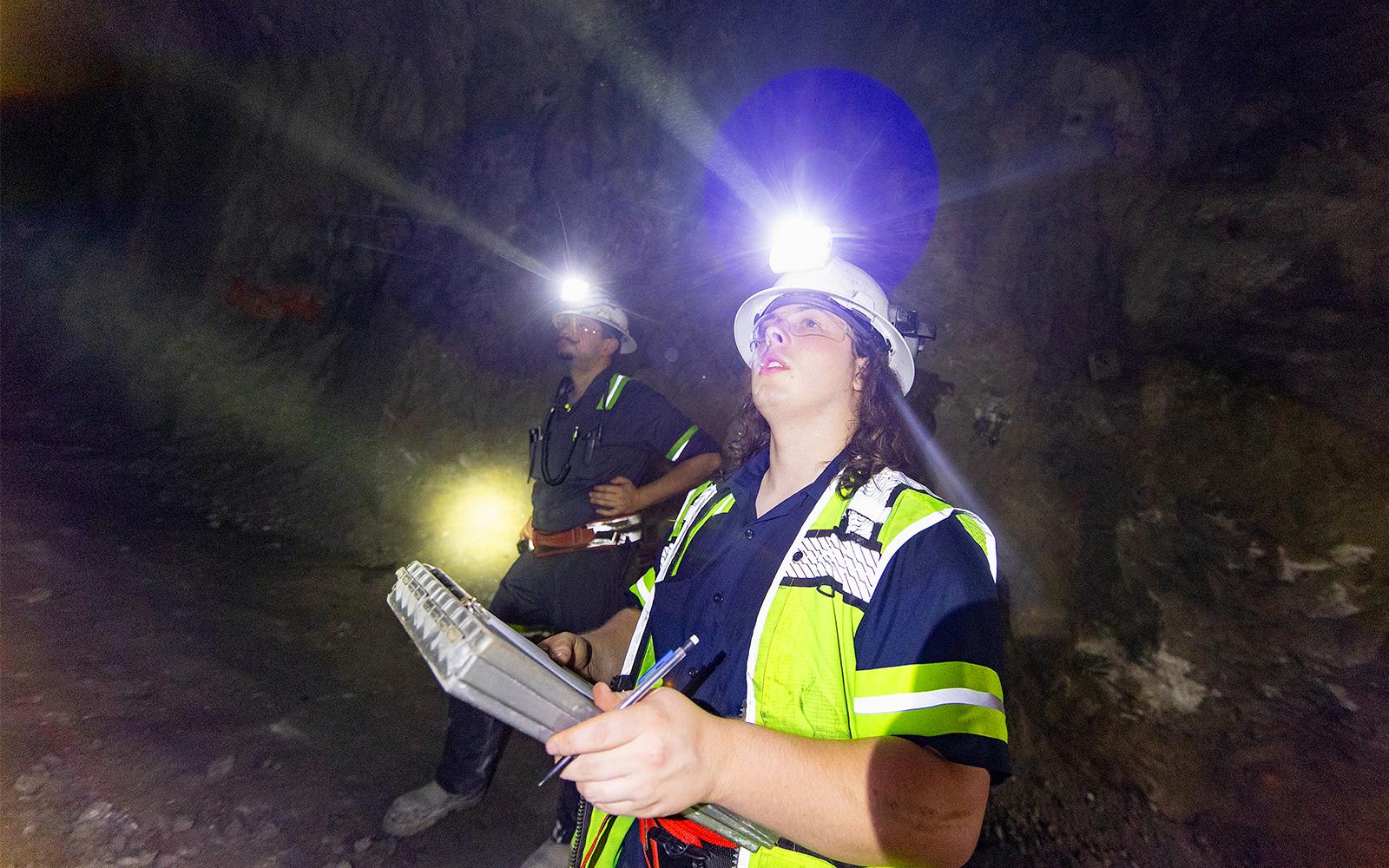
Ty Paddock '25 takes notes and maps a newly exposed rock face in the mine.
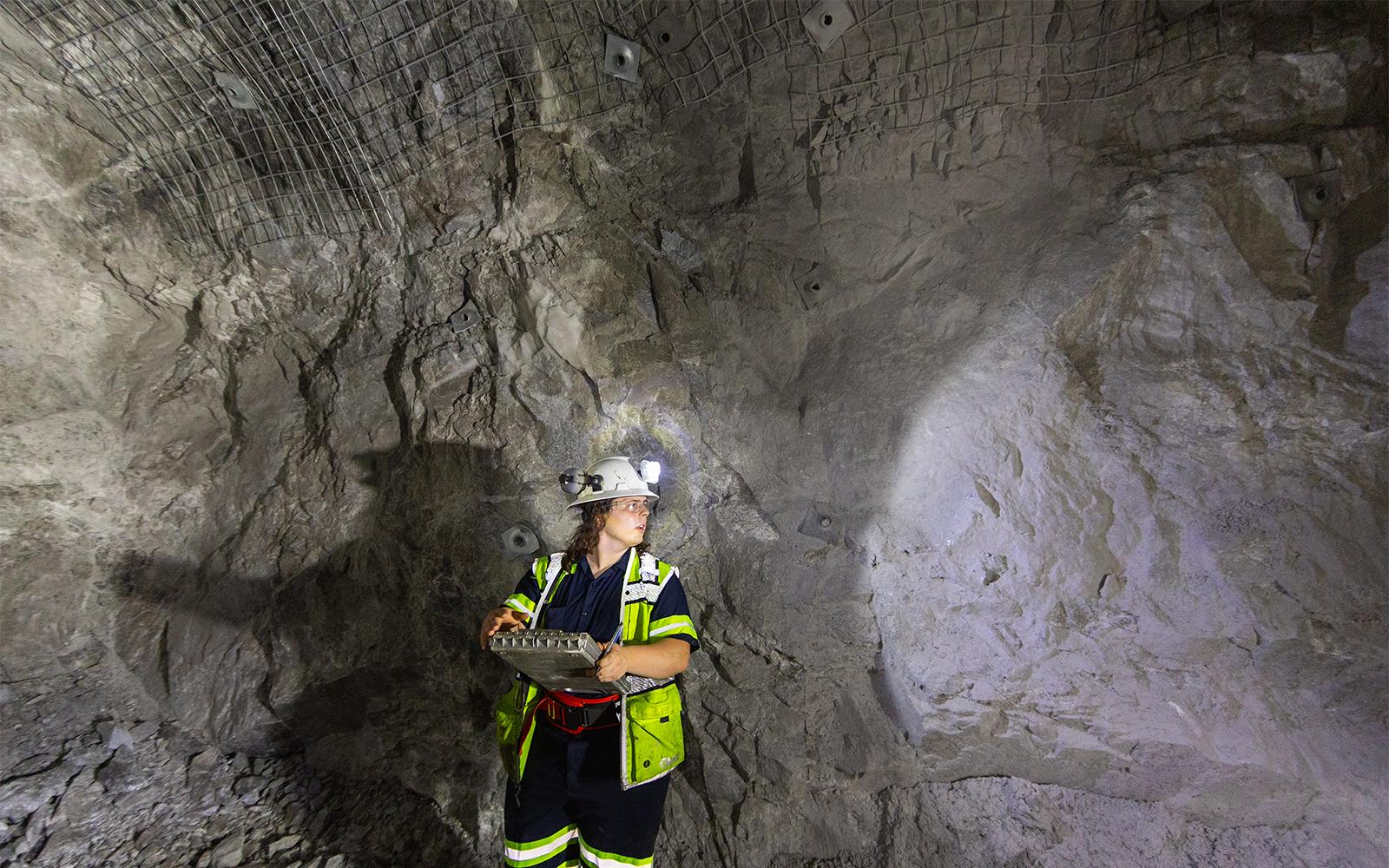
“We travel through the underground mine and arrive at all the locations the company plans to drill,” Paddock explained. “Each heading is unique. Once I’m trained, it’ll be my job to visit each one that’s recently been blasted and record what I see.”
Every observation counts. The data collected by Paddock and Frisco on mineral content, texture, and grade helps determine the next drilling targets in the mine’s zinc-rich formations.
"We’ll take notes on specific bands of mineralized material and give it a grade,” Frisco said. “Back on the surface, we run the data through ArcGIS for precise calculations. That gives us the face grade, and that tells operations the percent of zinc if we take this next round.”
Above Ground: Searching for the Next Big Find
While Frisco and Paddock work deep underground, another SUNY Potsdam graduate, Jesse Bullock ’25, surveys potential new mineral deposits across the region. As an exploration junior geologist, Bullock studies rock formations and analyzes core samples—long, cylindrical sections of earth—to pinpoint future drilling sites.
“That’s the process of looking over the core with a fine-toothed comb, documenting the rock units and any structural, mineralization, and alteration features that may have a positive or negative impact on a project,” Bullock said. “Our job is to relay information to the engineers and other geologists so they can determine if getting to the mineralized section is safe, and if it is economically viable.”
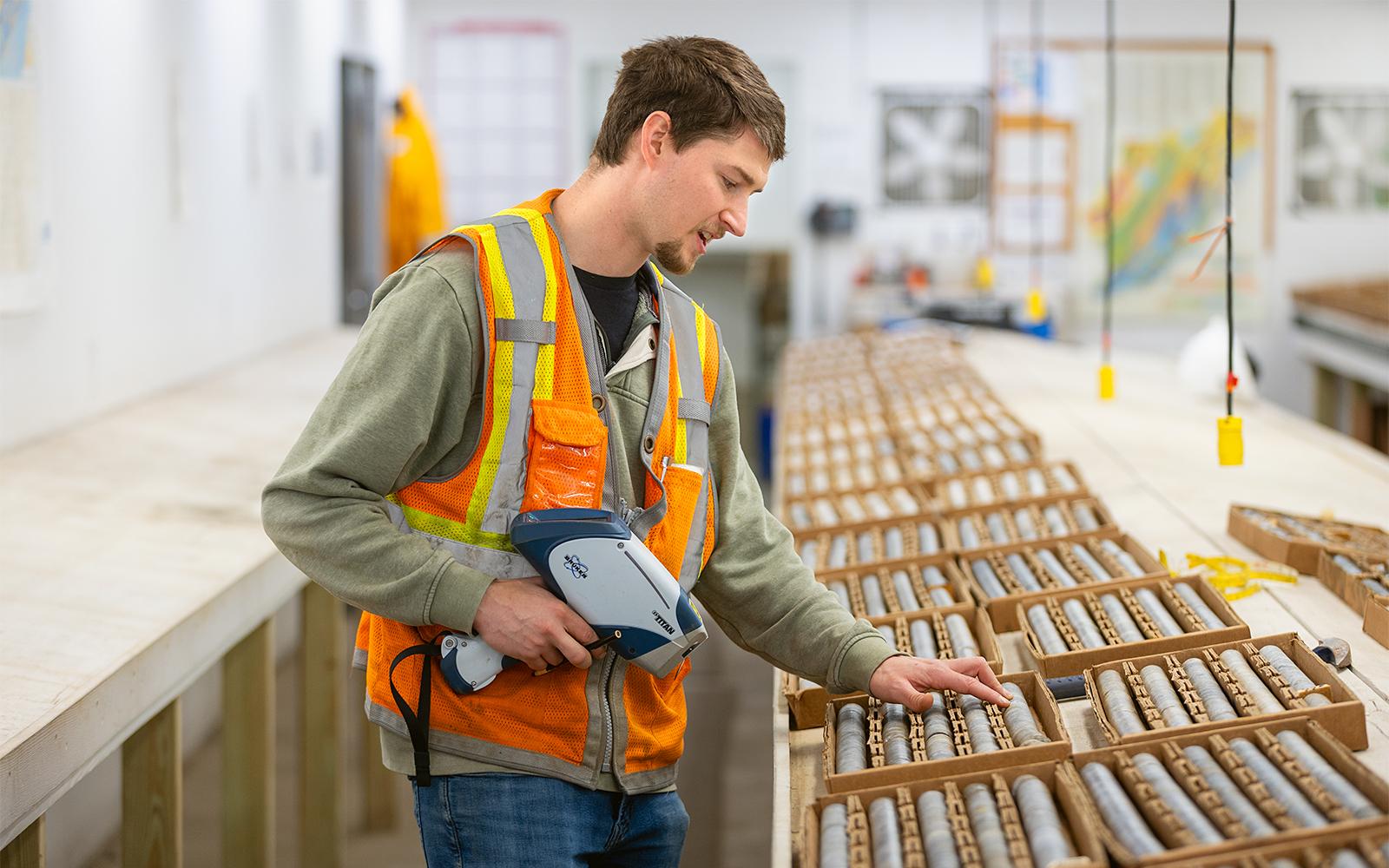
Jesse Bullock stands over a box of core samples at the Empire State Mine.
Bullock’s research team recently made a major discovery: a massive graphite deposit—estimated at 22 million tons—hidden beneath Northern New York. The find has launched a new graphite project at the Empire State Mine, positioning it to become the first graphite supplier in the U.S. in more than 70 years. Graphite is a key ingredient in lithium-ion batteries, electric vehicles, and even pencils—making this discovery both scientifically and economically significant.
Building Strong Foundations at SUNY Potsdam
For Paddock, Frisco, and Bullock, their time at SUNY Potsdam was more than a degree—it was the launchpad for their careers. The College’s geology program blends rigorous academics with real-world application, offering courses like Climate Change, Geomorphology, Mineralogy, and Structural Geology.
“Those classes, combined with the unique personalities and teaching styles of the professors created an incredibly enriching and fulfilling learning experience. I had no idea how much I was going to enjoy geology and the opportunities that were going to open for me by pursuing a geology degree.”
That hands-on learning extends to professional readiness. Under the mentorship of Dr. Mike Rygel, SUNY Potsdam students prepare for the New York State Fundamentals of Geology (FG) exam—a key step toward earning their Professional Geologist (PG) license.
“Our Bachelor of Science degree in geology is recognized as a licensure qualifying degree by New York State Education Department,” Rygel explained. “This is a designation that less than half of the geology programs in the state have sought out. The biggest perk that comes with that designation is that it allows our graduates to sit for the Fundamentals of Geology exam once they get within 20 credits of graduation.”
In March 2025, five SUNY Potsdam seniors took advantage of that opportunity—and all five passed. Their 100 percent success rate far exceeded both the national (68.4 percent) and state (73.7 percent) averages.
“I’ll attribute that success to our comprehensive curriculum,” Rygel said. “Our students take formal coursework in all eight of the content areas on the exam. That gives them an exceptional foundation.”
Turning Preparation into Opportunity
Paddock credits SUNY Potsdam’s geology faculty for helping him succeed.
“My education at Potsdam was crucial to pass this exam,” he said. “The professors were amazing. Dr. Rygel offered to help every student, and every week had a different study topic. When it came to the hiring process, passing the FG showed employers that I had a solid fundamental grasp of geology.”

Dr.. Mike Rygel, left, leads a discussion with students in his Sedimentary Geology class. Also pictured is Ty Paddock, right, who now works at the Empire State Mine.
Bullock agrees. “It was the hardest exam I’d ever taken, which made passing it that much sweeter. It was a brain cruncher, with questions that required a deep understanding of geology and 3D space. I don’t know where I’d be without Dr. Rygel, Dr. Schrader and my other professors. They ensured that we were going into the test as prepared as we possibly could.”
Their success was made possible, in part, through support from the Department of Earth and Environmental Science (which houses the geology program), the School of Arts & Sciences, and the Lougheed Center for Applied Learning, which helped offset exam and travel costs. Building on that momentum, SUNY Potsdam’s geology faculty have now developed a year-long review course to help future students prepare.
A Legacy of Leadership
In addition to teaching, Dr. Rygel serves as president of the New York State Council of Professional Geologists and associate editor of the Canadian Journal of Earth Science. Each summer, he co-teaches Indiana University’s field geology course in the Rocky Mountains—an experience many Potsdam students have attended over the years.
“I will put our motivated students and our geology degree up against anybody anywhere in NYS—public, private, big, small—nobody does it better and more cost effectively than we do."
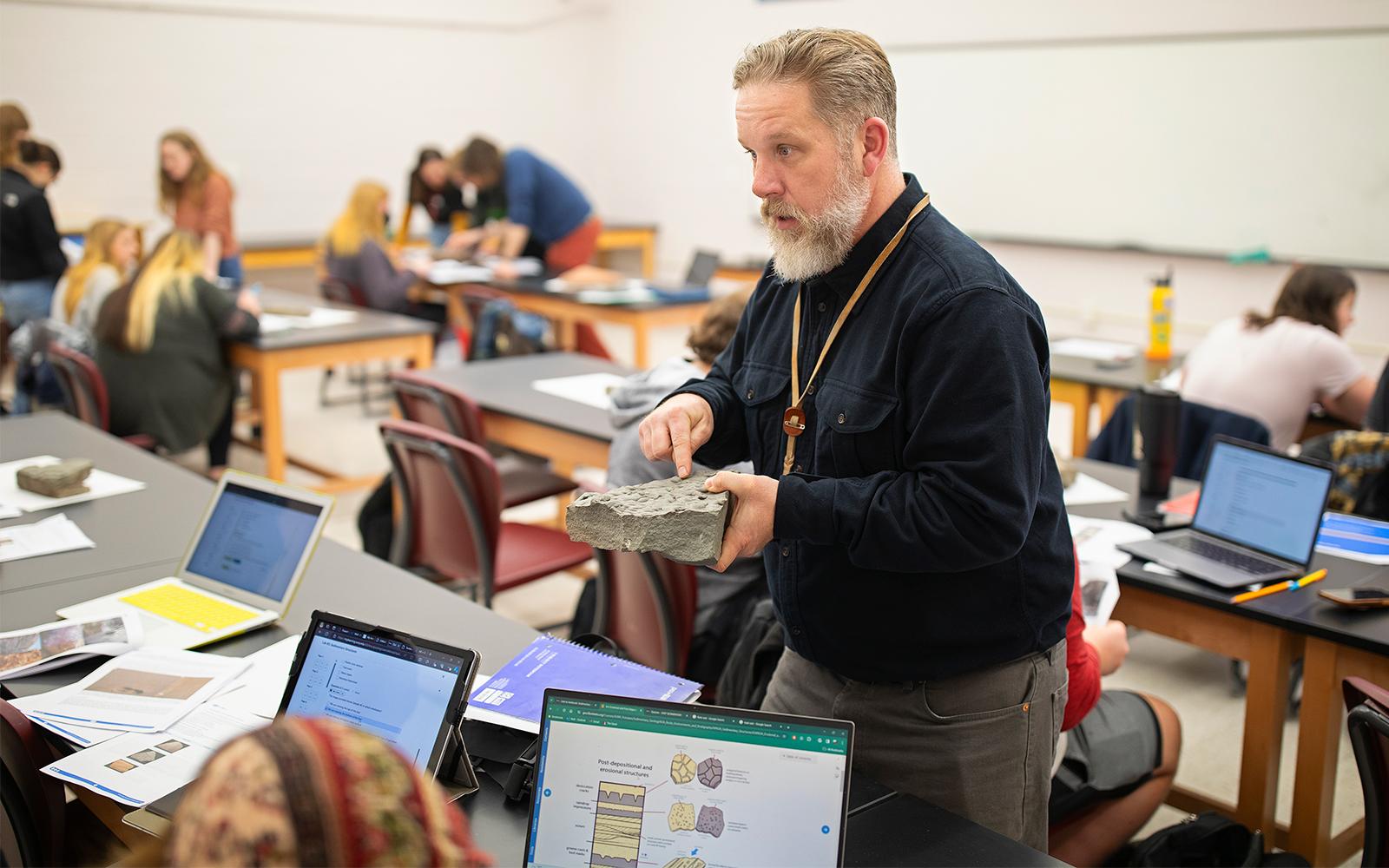
That record of success speaks for itself. SUNY Potsdam alumni hold positions across the globe—from Evan Smith ’12, Geosteering Lead for Halliburton in the Caribbean, to John Armitage ’11, who manages PCB cleanup for the NYS Department of Environmental Conservation, and Chris Mack ’12, a mining consultant who spent a decade exploring Alaska and Nevada.
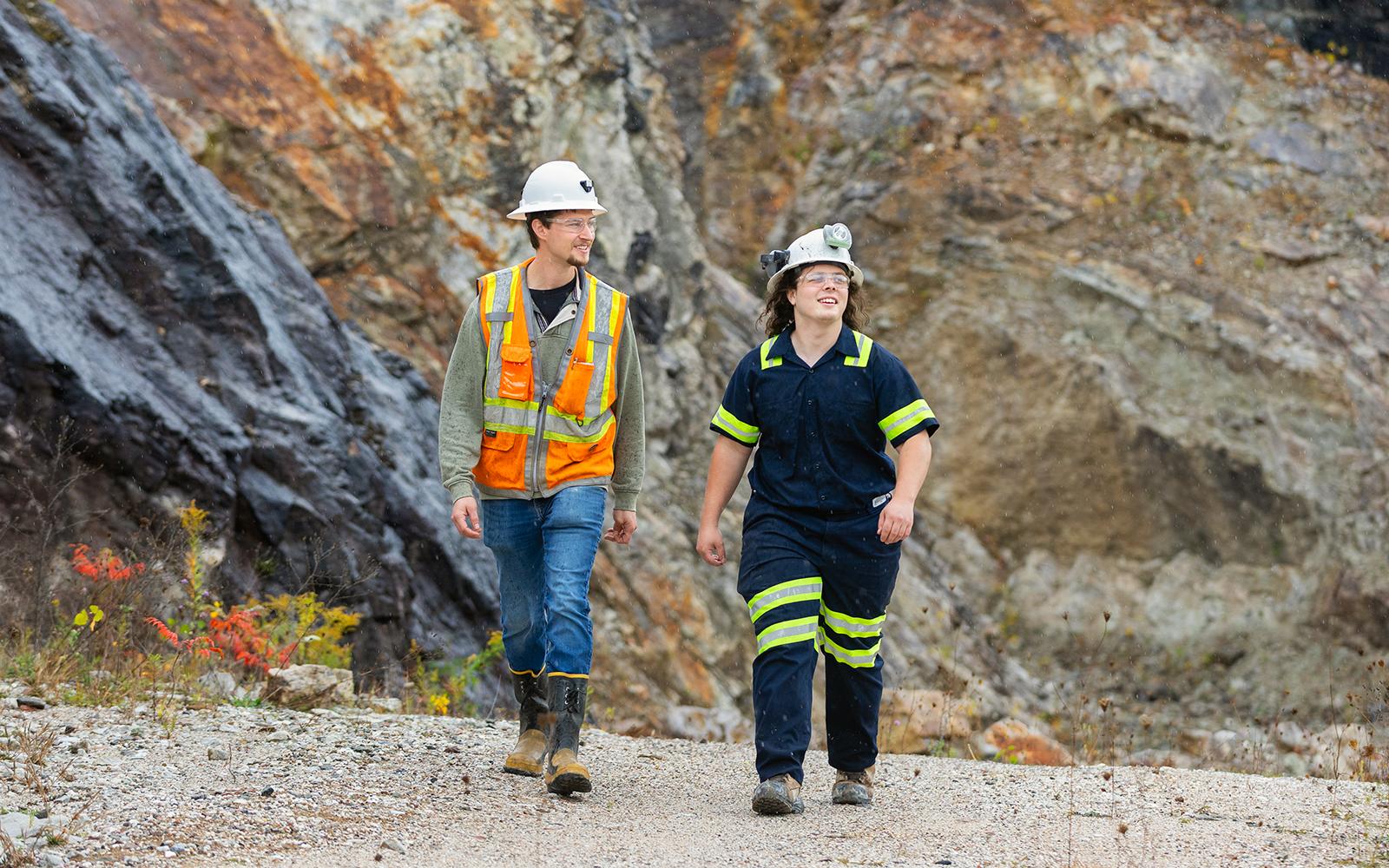
Jesse Bullock, left, and Ty Paddock walk past large rock formations in Fowler, N.Y.
Closer to home, Paddock, Frisco, and Bullock continue that tradition—turning their Potsdam education into thriving careers in the North Country.
“After a short time at SUNY Potsdam, I knew I had made the right choice. I’d recommend the geology program to anyone,” Bullock said. “The professors I had are the cream of the crop, being some of the smartest, kindest and most ambitious people I’ve ever met.”
Article and Photos by Jason Hunter
